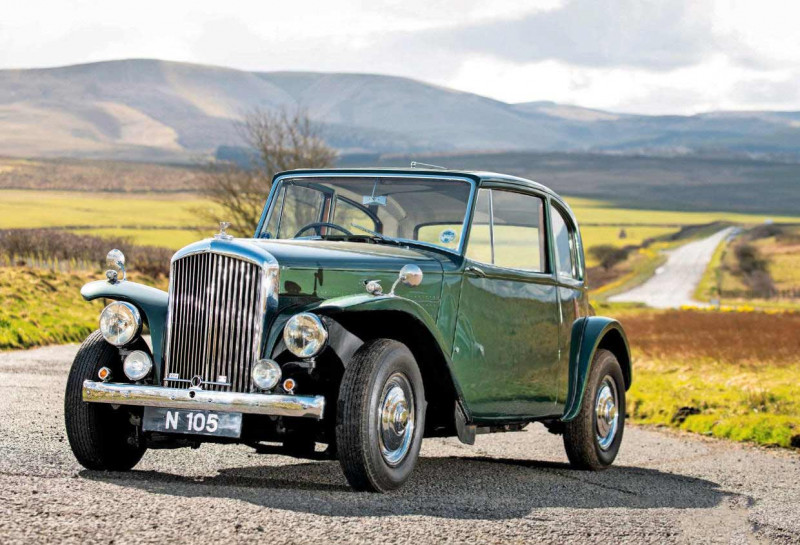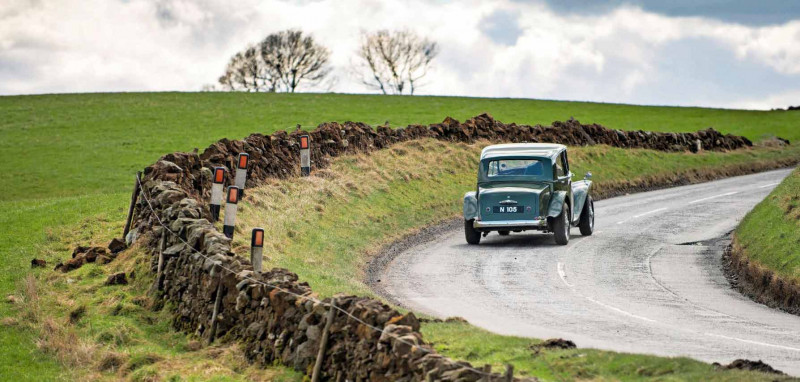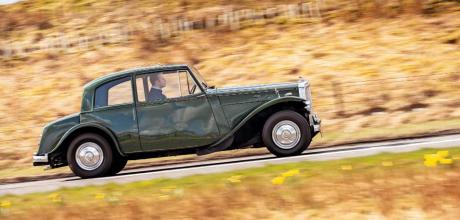1946 Bentley MkVI by HJ Mulliner
This unusual Bentley MkVI was commissioned by a man with particularly rigid views on the way his cars should be. Was he onto something? Words Nigel Boothman. Photos Andy Mcandlish.
BENT OUT OF SHAPE
Urban Bentley? The unique charms of the quirky McLeod Mulliner MkVI
Driving one of the strangest Bentleys ever made: McLeod’s MkVI
Yes, it’s an odd-looking thing. When you first see it, you immediately ponder its origins. A Bentley MkVI special made by an eccentric customiser? A body intended for some other marque and model that’s wound up on a Bentley chassis? Perhaps a prototype for a short-chassis MkVI?

In truth, our subject is none of the above. It wears coachwork created by HJ Mulliner for a repeat customer, Australian-born businessman Roderick McLeod. He had already owned two Derby Bentley chassis that had both been clothed in a stubby Mulliner body to his own specification by the time he ordered this one in 1946, and he would go on to commission six more. Almost all of them have common themes – far less weight than standard, much-reduced overhangs, little patience with conventional ideas of beauty. That’s not a mealy-mouthed way of saying they’re ugly. McLeod simply wanted his cars to do a certain job; looks came second. And to find out what he was aiming for, you need to drive it.
‘McLeod simply wanted his cars to do a certain job; looks came second’
The broad, comfy seats and that slab of dashboard timber are conventional enough but that’s where the similarity to a standard MkVI cabin ends. There’s a Plexiglass sunroof panel, a rather pre-war wind-out windscreen and more light and visibility than any normal MkVI offers. Flick the ignition switch to ‘on’, poke the starter and the engine comes to life with the suppressed murmur you only get from the beefy Rolls/Bentley inlet-over-exhaust straight six. The familiar right-hand change is here, though, and this one is particularly nice – weighty, slick and free of slop.

There’s abundant torque and the car feels light, so it’s happy to move off in second. Indeed, it’s willing to rev out rather quickly in second and third, hitting 50mph in no time. Gearing is low and after galloping up to 60mph in fourth, you find yourself looking for fifth or an overdrive switch. No such luck – the performance, the easy synchromesh gearchange and the smooth, comfortable ride have fooled us into expecting this car to behave like something much younger. But at the time, an effortless 60mph with enough in reserve to charge past 90mph was more than adequate.
The brakes are up to the job too, which is less easy to claim for the tyres. These Dunlop cross-plies are good as cross-plies go, but their behaviour is still a throwback. They’re nervous, keen to follow their own path and yet reluctant to change direction when forced to do so. Radials might transform the B-road behaviour, though at expense of even heavier steering at parking speeds.
While every old Bentley would feel good on these sweeping A-roads and B-roads south of Edinburgh, this one would do just as well in the city. The lightness, the low gearing, the narrow body and sawn-off corners make it almost comically manoeuvrable for something with a standard MkVI wheelbase. Yes – while Mulliner was content to lop a total of nine inches off the chassis overhangs, the ten-foot wheelbase remained standard, removing any need to modify the driveline or lose room in the cabin. These mechanically servo-assisted brakes would stop you nimbly whenever a wayward cab darted out of a sidestreet, too.
The ‘urban Bentley’ theory makes sense when you know that McLeod lived in Harrow and had his factory in King’s Cross. Today, that would be a grim hack of an hour or more through 15 miles of traffic, and even in 1947 it would have felt much easier in something nimble. McLeod may simply have been fond of efficiency – he wanted the comfort and performance of the new-model Bentley but was loathe to cart all that Standard Steel bodywork and the extra pair of doors everywhere he went.
But the styling… why the pre-war throwbacks? The unfaired headlamps, the wind-out windscreen, the boot that’s separate from the rest of the body. Well, McLeod started choosing his own coachwork in 1934 with a conventional two-door, four-light 3½ Litre saloon commissioned from HJ Mulliner and transferred in 1936 to a new 4¼ chassis. But then in September 1938 he took delivery of another 4¼ built from ideas and/or sketches he’d provided. It was a close-coupled, two-door saloon with an abbreviated boot, lightweight open-sided wings and a glass panel in the roof. This body was transferred after only six months onto an overdrive 4¼ Litre chassis, B142MR. The MkVI we’re driving today is, in part, a post-war interpretation of that design.
Bentley announced the new MkVI model to the public in May 1946, by which time McLeod was already making plans. He seems to have written to the firm in August 1945, perhaps wielding a bit of influence as a good repeat customer. Sure enough, he managed to place an order with John Croall & Sons, Rolls-Royce agents and owners of HJ Mulliner, on 22nd May 1946 with his specifications for the body.
Quite why the body took on its final form would be a matter of conjecture were it not for a lucky chance. In late 1985 or early 1986, Eric Lister wrote a piece for a car magazine on the American racing driver and collector ‘Ace’ Rosner, who at the time owned McLeod’s 4¼ coupé, B142MR. During the creation of the article, Rosner bumped into someone who recognised the car and told him that Captain McLeod was still alive and well in Harrow. A meeting was arranged, and they found the 94-year-old McLeod ‘completely on the ball’, with an ‘amazing memory’.
His aim for all his cars, he said, was to avoid overhangs and have a wheel at each corner. If you want to carry luggage, you dump it on the rear seat – he did not believe in carting an excess of mostly unused space around with him. He also believed closed cars were far superior for long-distance motoring but must be light and airy. Fellow Australian HG Johnstone of HJ Mulliner apparently became an ally and collaborated with him on his various special Bentleys. Then comes the specific insight to ‘our’ MkVI.
Because of wartime petrol shortages, McLeod sold the 4¼ and bought a Lancia Aprilia, a car whose handling and engineering he admired enormously. He then tried a Citroën Light 15, another design with a wheel at each corner and ‘incorporated the Citroën front wing design on his first HJ Mulliner postwar Bentley in 1947’. The article goes on to say that ‘Mac’, as he insisted on being called, described the car as a killer with primitive independent front suspension and atrocious handling!
That’s hardly been my impression today, but perhaps I haven’t been thrashing it like Mac once did. Regardless of this, you have to admit that McLeod’s insistence on a mix of styling features makes for an odd result. The front wings are only a little like a Traction Avant’s, and the MkVI chassis has imposed proportions that a Derby Bentley doesn’t have. The bonnet line is much higher when compared with the top of the front wheel, the wheels are smaller and the cabin is longer; the radiator is further forward, well past the front axle line. The whole is effect is strangely un-Bentley like because we associate postwar Bentleys with being large, gracious and heavy-looking, three adjectives that don’t really apply to this car.
Speaking of weight, the MkVI Standard Steel saloon is usually quoted at 1854kg. An R-type Continental, substantially the same chassis but with a long, streamlined aluminium coupé body, weighed about 200kg less at 1650kg. McLeod’s car is a full two feet shorter and a foot narrower than the Conti and is also bodied in aluminium, so it would be strange if it didn’t save another 100kg, probably more. If it’s below 1500kg, that makes it less than an Alvis TA21, but with an extra 1.3 litres. No wonder it goes well.
It’s set up for ride comfort rather than stiffness or sporty handling. It’s pliant and relaxing even over second-rate surfaces and you only pay a penalty for this if you arrive at a corner too fast or find a sweeping bend that tightens unexpectedly. Then the body roll asserts itself, the cross-plies try to peel off the rims and you hang on until everything’s back on an even keel.
Looking around the cabin, you can put yourself in Roderick McLeod’s place and look for his touches. On the dash we find unusual Rotax H2803 dimmable lights, often found on aircraft cockpit panels. Each one has a multi-leaf aperture like a camera lens and can be twisted from fully open to almost shut, perhaps to reduce the distraction when driving on a dark night. The gear lever, down to the right of the seat, has a cut-out for your hand in the door’s inner panel that’s larger than that in standard MkVI saloons, such is the narrowness of McLeod’s favoured bodywork. Gazing forward, you notice rows of rivets along the edges of the bonnet panels and large round studs of the type used on pre-war cars when one half of the bonnet was open and resting on the other. But in both cases these features are purely cosmetic on this car. It’s all detailed in a beautiful hand-written order sheet from HJ Mulliner, which also reveals the original colour scheme, ‘Fish silver metallic’ with black wings and dark brown Vaumol hide.
There are some real oddities in the early documentation. After taking delivery in March 1947, McLeod seems to have spent three months performing his own shake-down procedure and then returned the car for some tweaks. These cover all sorts, from fitting extra front wing stays to replacing the standard exhaust valve springs with ‘Swedish Iron Wire’ springs. McLeod’s firm was involved in metallurgical work so perhaps he had fixed views on what was best. Other details now seem inexplicable; he must have supplied the car’s small eight-inch Lucas ‘King of the Road’ lamps himself, because there’s a line in the bill for taking the dents out of them and having them re-plated.
The whole lot cost McLeod an enormous sum – £1750 for the body plus £1785 for the chassis, but minus a generous discount of 16.6% (we can only guess how he managed that), producing a bill of £2948, 1s 8p. To this figure we add purchase tax of £982, 13s 11p meaning this was a £4000 car at a time when standard MkVI saloon was £3000 and a new Ford V8 Pilot less than £750.
The McLeod family kept the car until 1952 when it was replaced (see ‘The Other McLeod Cars’, page 91) and sold on. It passed through a few more owners in the Fifties before settling down to longer ownerships in following decades. It’s currently in the care of Marcus Dean, who has plenty of experience with unique Rolls-Royce and Bentley cars and is something of an aficionado of one-off coachwork. He finds McLeod’s car enjoyable to throw round Edinburgh’s narrow city streets, unlike most of its brethren, which brings us back to its original purpose. It’s not, as some lightweight two-door MkVIs are, a precursor to the high-speed touring elegance of the R-type Continental. It’s a venture down a less obvious path – take all the quality, power and comfort of a Bentley and make it small and wieldy. Make it fit into parking spaces and smaller garages without worrying about acres of billowing panelwork. Give it the visibility you’d expect from a drophead coupé with the top down. Make it, in other words, user-friendly. That’s a jargon phrase not seen until decades after this car was finished, and perhaps Roderick McLeod’s alternative vision of a Bentley was simply ahead of its time too.
Thanks to: Marcus Dean, Tom Clarke, Bernard King/Complete Classics, Klaus-Josef Rossfeldt
In McLeod’s ownership it wore his personal plate, H1, before being re-registered LMU 578 after sale, then X88 and N105
TECHNICAL DATA FILE 1946 Bentley MkVI by HJ Mulliner
- Engine 4257cc, inline six-cylinder, ioe, twin SU H4 carburettors
- Power and torque 137bhp @ 4000rpm; torque n/a
- Transmission Four-speed manual, rear-wheel drive
- Steering Cam and roller, unassisted
- Suspension Front: independent by coil springs, wishbones, lever-arm hydraulic dampers. Rear: live axle, leaf springs, adjustable lever-arm hydraulic dampers
- Brakes Front: hydraulic drums. Rear: mechanical drums
- Gearbox-driven servo assistance
- Performance 0-60mph: 13sec (est).
- Top speed: 95mph (est)
- Weight 1475kg (est)
- Fuel consumption 18mpg (est)
- Cost new£3930
Classic Cars Price Guide n/a (standard saloon £15.5k-£35.5k; convertible £45k-£120k)
Rotax lights below, apertures opened by knurled edges 4.3-litre ioe six is standard: extra ‘go’ comes from weight saving.
McLeod found fellow Aussie at HJ Mulliner to help develop ideas.
Valve radio vulnerable to drips from the opening windscreen Centre console with ashtray is a non-McLeod item added later Standard
‘His aim was to avoid overhangs and have a wheel at each corner’


